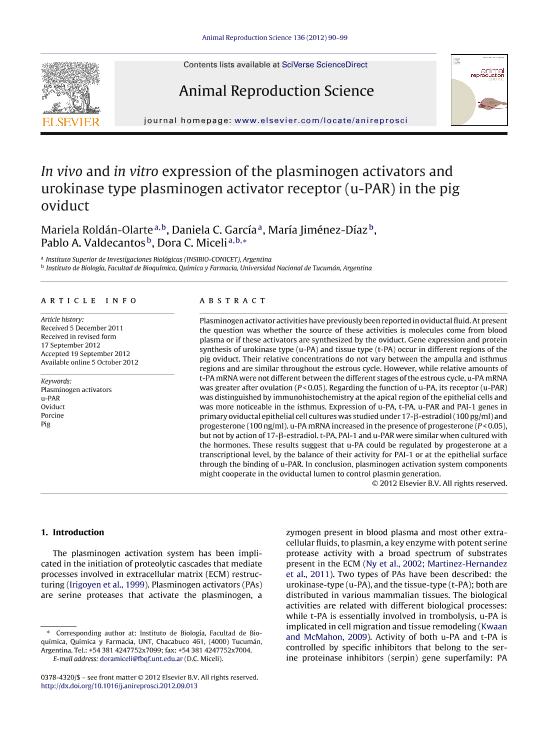Artículo
In vivo and in vitro expression of the plasminogen activators and urokinase type plasminogen activator receptor (u-PAR) in the pig oviduct
Roldán-Olarte, Mariela; Garcia, Daniela Celeste ; Jiménez Díaz, María Atilana; Valdecantos, Pablo Alberto; Miceli, Dora Cristina
; Jiménez Díaz, María Atilana; Valdecantos, Pablo Alberto; Miceli, Dora Cristina
 ; Jiménez Díaz, María Atilana; Valdecantos, Pablo Alberto; Miceli, Dora Cristina
; Jiménez Díaz, María Atilana; Valdecantos, Pablo Alberto; Miceli, Dora Cristina
Fecha de publicación:
12/2012
Editorial:
Elsevier Science
Revista:
Animal Reproduction Science
ISSN:
0378-4320
Idioma:
Inglés
Tipo de recurso:
Artículo publicado
Clasificación temática:
Resumen
Plasminogen activator activities have previously been reported in oviductal fluid. At present the question was whether the source of these activities is molecules come from blood plasma or if these activators are synthesized by the oviduct. Gene expression and protein synthesis of urokinase type (u-PA) and tissue type (t-PA) occur in different regions of the pig oviduct. Their relative concentrations do not vary between the ampulla and isthmus regions and are similar throughout the estrous cycle. However, while relative amounts of t-PA mRNA were not different between the different stages of the estrous cycle, u-PA mRNA was greater after ovulation (P< 0.05). Regarding the function of u-PA, its receptor (u-PAR) was distinguished by immunohistochemistry at the apical region of the epithelial cells and was more noticeable in the isthmus. Expression of u-PA, t-PA, u-PAR and PAI-1 genes in primary oviductal epithelial cell cultures was studied under 17-β-estradiol (100. pg/ml) and progesterone (100. ng/ml). u-PA mRNA increased in the presence of progesterone (P< 0.05), but not by action of 17-β-estradiol. t-PA, PAI-1 and u-PAR were similar when cultured with the hormones. These results suggest that u-PA could be regulated by progesterone at a transcriptional level, by the balance of their activity for PAI-1 or at the epithelial surface through the binding of u-PAR. In conclusion, plasminogen activation system components might cooperate in the oviductal lumen to control plasmin generation.
Palabras clave:
OVIDUCT
,
PIG
,
PLASMINOGEN ACTIVATORS
,
PORCINE
,
U-PAR
Archivos asociados
Licencia
Identificadores
Colecciones
Articulos(INSIBIO)
Articulos de INST.SUP.DE INVEST.BIOLOGICAS
Articulos de INST.SUP.DE INVEST.BIOLOGICAS
Citación
Roldán-Olarte, Mariela; Garcia, Daniela Celeste; Jiménez Díaz, María Atilana; Valdecantos, Pablo Alberto; Miceli, Dora Cristina; In vivo and in vitro expression of the plasminogen activators and urokinase type plasminogen activator receptor (u-PAR) in the pig oviduct; Elsevier Science; Animal Reproduction Science; 136; 1-2; 12-2012; 90-99
Compartir
Altmétricas



